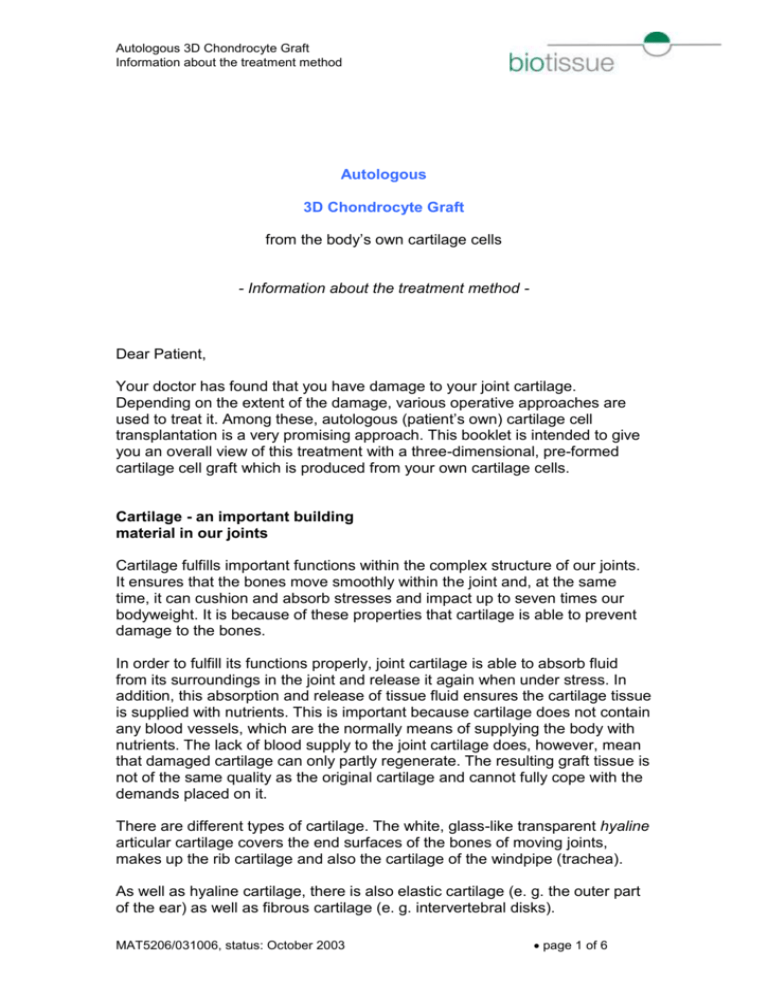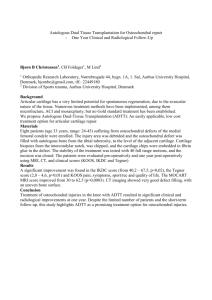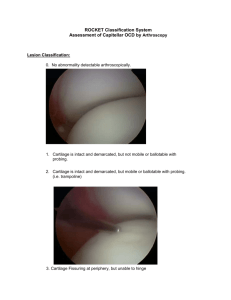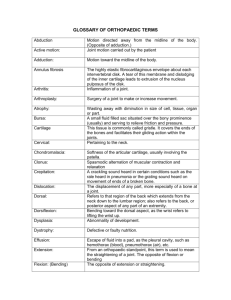3D Chondrocyte Graft - BioTissue Technologies GmbH
advertisement

Autologous 3D Chondrocyte Graft Information about the treatment method Autologous 3D Chondrocyte Graft from the body’s own cartilage cells - Information about the treatment method - Dear Patient, Your doctor has found that you have damage to your joint cartilage. Depending on the extent of the damage, various operative approaches are used to treat it. Among these, autologous (patient’s own) cartilage cell transplantation is a very promising approach. This booklet is intended to give you an overall view of this treatment with a three-dimensional, pre-formed cartilage cell graft which is produced from your own cartilage cells. Cartilage - an important building material in our joints Cartilage fulfills important functions within the complex structure of our joints. It ensures that the bones move smoothly within the joint and, at the same time, it can cushion and absorb stresses and impact up to seven times our bodyweight. It is because of these properties that cartilage is able to prevent damage to the bones. In order to fulfill its functions properly, joint cartilage is able to absorb fluid from its surroundings in the joint and release it again when under stress. In addition, this absorption and release of tissue fluid ensures the cartilage tissue is supplied with nutrients. This is important because cartilage does not contain any blood vessels, which are the normally means of supplying the body with nutrients. The lack of blood supply to the joint cartilage does, however, mean that damaged cartilage can only partly regenerate. The resulting graft tissue is not of the same quality as the original cartilage and cannot fully cope with the demands placed on it. There are different types of cartilage. The white, glass-like transparent hyaline articular cartilage covers the end surfaces of the bones of moving joints, makes up the rib cartilage and also the cartilage of the windpipe (trachea). As well as hyaline cartilage, there is also elastic cartilage (e. g. the outer part of the ear) as well as fibrous cartilage (e. g. intervertebral disks). MAT5206/031006, status: October 2003 page 1 of 6 Autologous 3D Chondrocyte Graft Information about the treatment method Cartilage is largely made up of a network of tissue consisting of a few cartilage cells (chondrocytes) which are embedded in a characteristic matrix (surrounding substance) formed by you yourself. The constituents of this matrix - type II collagen and proteoglycans - are taken as specific proof of the presence of hyaline cartilage and are crucial to how well it performs its functions. Damage to joint cartilage Millions of people all over the world suffer from defective joint cartilage. In Germany alone, there are thousands of patients each year with cartilage problems in their knee joints. This damage can result from age-related wear and tear or be caused by sports injuries, for instance. If left untreated, deepseated cartilage defects will considerably reduce the quality of life and, at worst, can cause persistent pain and loss of function. Ultimately the picture of osteoarthritis will develop (chronic, painful joint disease with permanent articular damage). Joint cartilage [with the underlying bone] can be divided into six zones: 1) 2) 3) 4) 5) 6) surface cartilage zone middle cartilage zone deep cartilage zone calcified cartilage zone subchondral bone plate (calcified) bone A defect in the upper layers of cartilage does not necessarily warrant surgery. A number of methods can be used for minor damage in order to stimulate regeneration of the articular cartilage. These include methods such as flushing out the joint (lavage), drilling the bone underlying the cartilage (microfracturing) and removal of the diseased cartilage (abrasion). These do relieve the symptoms but they cannot restore any hyaline cartilage. Defects measuring up to about 3 cm2 can be treated by grafting cylinders of the patient’s own bone/cartilage from minimally stressed, healthy areas of joint cartilage into the affected areas (mosaic-plasty or OATS). MAT5206/031006, status: October 2003 page 2 of 6 Autologous 3D Chondrocyte Graft Information about the treatment method Outerbridge-classification Grade 0 Grade I Grade III Grade IV Grade II Transplantation of the patient’s own cartilage cells can be used, particularly for larger cartilage damage over 3 cm2 in area, with an Outerbridge classification (severity of a cartilage injury) of grade III or IV. Autologous (patient’s own) Chondrocyte Transplantation (ACT) has proved to be a promising method for deep-seated damage to articular cartilage, which leads to the defects being refilled with hyaline cartilage. Healthy autologous cartilage cells are collected during the course of arthroscopy (procedure to visualize inside the knee joint) and these are used to grow more cells in the laboratory. After a few weeks a suspension (fluid) containing cartilage cells is available to the patient and this is injected into the defect during transplantation. The site is then covered over with a flap of periosteum (connective tissue covering bone) previously taken from the tibia (shinbone). Autologous 3D Chondrocyte Graft An Autologous 3D Chondrocyte Graft is made up of the patient’s own cartilage cells which, together with a “bio-adhesive”, are embedded in an biodegradable fleece (i. e. it can be degraded by the body). In developing this pre-formed cell graft, the company has drawn on years of experience with the autologous, liquid ACT method and turned that experience into key product and handling advantages. MAT5206/031006, status: October 2003 page 3 of 6 Autologous 3D Chondrocyte Graft Information about the treatment method Unlike the ACT method, the use of a pre-formed 3D Cartilage Graft does not require a periosteal flap to be removed to cover the defect. This avoids the pain at the donor site and greatly simplifies the procedure for the surgeon, whilst considerably shortening the operating time. The use of pre-formed Autologous 3D Cartilage Graft makes it possible to produce cartilage tissue very similar to hyaline cartilage, which can almost entirely fulfill the functions of articular cartilage. This means the affected joint is fully operational again. Treatment procedure with Autologous 3D Cartilage Graft 1) The diagnosis and suitability for 3D Cartilage Graft are established on the basis of the defect found during arthroscopy (visualization of the knee joint). 2) In order to produce the Autologous 3D Cartilage Graft, about 250 mg of cartilage tissue will be taken from an area of your knee joint cartilage that is subject to little stress and the tissue is increased by the technique of cell culturing in a laboratory. (View of damage to articular cartilage through an arthroscope) 3) The patient’s own blood serum is one of the means used to supply the newly cultured cartilage cells with nutrients. This is why a blood donation from the patient is required. This blood donation takes place when the biopsy is removed. So that the cells grow as well as possible, you should only eat light, extremely low-fat food during the 12 hours before the blood sample is collected, e. g. bread, jam, honey, yogurt, fruit juice, no butter. 4) The cartilage cells and the blood are delivered to the cell culture laboratory by a reliable transportation service. MAT5206/031006, status: October 2003 page 4 of 6 Autologous 3D Chondrocyte Graft Information about the treatment method 5) In these specially equipped laboratories, which operate to the strictest cleanliness standards, the cartilage cells are dissolved out of the cartilage tissue, grown using the patient’s own blood serum and shaped into the final three-dimensional structure after approx. 21 days. 6) In time for transplantation, the 3D Cartilage Graft is delivered by courier service to the doctor carrying out the treatment. 7) During a single operation, the existing cartilage defect is first cleared of damaged cartilage tissue and the edges of the defect are smoothed. 8) The method of producing the 3D Cartilage Graft ensures that it contains a defined number of cartilage cells (approx. 24 million cells per cm3) in an even distribution. It also guarantees that the newly cultured cartilage cells are evenly distributed in the defect. 9) The pre-formed graft can simply be cut to the required size. Four anchoring stitches, tied to each corner, ensure that the Cartilage Graft is accurately fitted into the defect. The four stitches are securely anchored in the bone. This enables the cartilage cells to become incorporated into the defect. The carrier fleece is biodegraded within a period of six months. 10) Rehabilitation measures that are suited to your individual cartilage damage will ensure that the newly formed joint cartilage is incorporated, matures and hardens within a period of between six months and a year. MAT5206/031006, status: October 2003 page 5 of 6 Autologous 3D Chondrocyte Graft Information about the treatment method BioTissue Technologies GmbH Engesserstraße 4a / 4b D-79108 Freiburg Tel. +49 (0) 7 61 76 76-555 Fax +49 (0) 7 61 76 76-475 customerservice@biotissue-tec.com www.biotissue-tec.com MAT5206/031006, status: October 2003 page 6 of 6









